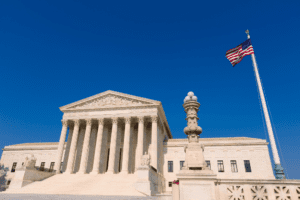 Justice Breyer continued: And other courts upheld concealed-carry restrictions without any reference to an exception allowing open carriage, so it is far from clear that the cases the Court cites represent a consensus view. See State v. Mitchell, 3 Blackf. 229 (Ind. 1833); State v. Buzzard, 4 Ark. 18 (1842). And, of course, the Court does not say whether the result in this case would be different if New York allowed open carriage by law-abiding citizens as a matter of course.
Justice Breyer continued: And other courts upheld concealed-carry restrictions without any reference to an exception allowing open carriage, so it is far from clear that the cases the Court cites represent a consensus view. See State v. Mitchell, 3 Blackf. 229 (Ind. 1833); State v. Buzzard, 4 Ark. 18 (1842). And, of course, the Court does not say whether the result in this case would be different if New York allowed open carriage by law-abiding citizens as a matter of course.
The second 19th-century innovation, adopted in a number of States, was surety laws. Massachusetts’ surety law, which served as a model for laws adopted by many other States, provided that any person who went “armed with a dirk, dagger, sword, pistol, or other offensive and dangerous weapon,” and who lacked “reasonable cause to fear an assault,” could be made to pay a surety upon the “complaint of any person having reasonable cause to fear an injury, or breach of the peace.” Mass. Rev. Stat., ch. 134, §16 (1836). Other States and Territories enacted identical or substantially similar laws. See, e.g., Me. Rev. Stat., ch. 169, §16 (1840); Mich. Rev. Stat., ch. 162, §16 (1846); Terr. of Minn. Rev. Stat., ch. 112, §18 (1851); 1854 Ore. Stat., ch. 16, §17; W. Va. Code, ch. 153, §8 (1868); 1862 Pa. Laws p. 250, §6. These laws resemble New York’s licensing regime in many, though admittedly not all, relevant respects. Most notably, like New York’s proper cause requirement, the surety laws conditioned public carriage in at least some circumstances on a special showing of need. Compare supra, at 13, with Mass. Rev. Stat., ch. 134, §16.
The Court believes that the absence of recorded cases involving surety laws means that they were rarely enforced. Ante, at 49–50. Of course, this may just as well show that these laws were normally followed. In any case, scholars cited by the Court tell us that “traditional case law research is not especially probative of the application of these restrictions” because “in many cases those records did not survive the passage of time” or “are not well indexed or digitally searchable.” E. Ruben & S. Cornell, Firearms Regionalism and Public Carry: Placing Southern Antebellum Case Law in Context, 125 Yale L. J. Forum 121, 130– 131, n. 53 (2015).
The dissent again undermines some of its own points by delving into a historical analysis. It criticizes the majority’s reliance on historians while repeatedly citing to historians.
